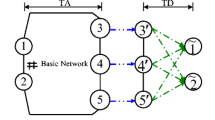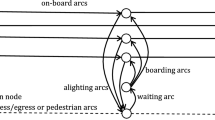Abstract
The combined distribution and assignment problem is the problem of the simultaneousdetermination of the distribution of trips between origins and destinations in a transportationnetwork and the assignment of trips to routes in each origin - destination pair. In the modelmost widely used, the distribution is assumed to follow a gravity model with a negativeexponential deterrence function and the assignment is made according to the deterministicuser equilibrium principle. In this paper, we describe an extension of this model in whichthe allocation of trips to routes is made according to the principle of stochastic user equilibrium.We discuss the behavioural foundations of trip assignment and combined modelsassuming deterministic or stochastic route choice. In particular, we describe how they can bederived using the efficiency principle from discrete choice theory; the combined distributionand stochastic assignment model is obtained as the continuous approximation of the discreteproblem of finding the most probable flow pattern under the assumption of efficient tripmaking behaviour. We outline an algorithm for the solution of the model which is based onroute (column) generation, disaggregate simplicial decomposition, and partial linearization.
Similar content being viewed by others
References
D. Bernstein and T.E. Smith, Programmability of discrete network equilibria, Statistics and Operations Research Technical Report SOR-94-19, Princeton University, Princeton, NJ, 1994.
D.E. Boyce, K.S. Chon, Y.J. Lee, K.T. Lin and L.J. LeBlanc, Implementation and computational issues for combined models of location, destination, mode and route choice, Environment and Planning A 15(1983)1219 – 1230.
O. Damberg, J.T. Lundgren and M. Patriksson, An algorithm for the stochastic user equilibrium problem, Transportation Research 30B(1996)115 – 131.
S. Erlander, On the principle of monotone likelihood and log-linear models, Mathematical Programming Study 25(1985)108 – 123.
S. Erlander, On the relationship between the discrete and continuous models for combined distribution and assignment, Transportation Research 22B(1988)371 –382.
S. Erlander, Efficient population behavior in networks, dispersed equilibrium and the combined distribution and assignment model, Report LiTH-MAT-R-89-07, Department of Mathematics, Linköping Institute of Technology, Linköping, Sweden, 1989.
S. Erlander, Efficient behavior and the simultaneous choices of origins, destinations and routes, Transportation Research 24B(1990)363– 373.
S.P. Evans, Derivation and analysis of some models for combining trip distribution and assignment, Transportation Research 10(1976)37 – 57.
C. Fisk, Some developments in equilibrium traffic assignment, Transportation Research 14B(1980)243 –255.
M. Frank and P. Wolfe, An algorithm for quadratic programming, Naval Research Logistics Quarterly 3(1956)95 – 110.
B. Lamond and N.F. Stewart, Bregman's balancing method, Transportation Research 15B(1981)239 – 248.
T. Larsson and M. Patriksson, Simplicial decomposition with disaggregated representation for the traffic assignment problem, Transportation Science 26(1992)4 – 17.
J.T. Lundgren, Optimization approaches to travel demand modelling, Doctoral Dissertation, Department of Mathematics, Linköping Institute of Technology, Linköping, Sweden, 1989.
J.T. Lundgren and M. Patriksson, An algorithm for the combined distribution and assignment model, in: Transportation Networks; Recent Methodological Advances, Proceedings of the 4th Meeting of the EURO Working Group on Transportation, Newcastle University, Newcastle, UK, September 9– 11, 1996, eds. R.E. Allsop and M.G.H. Bell (to appear).
M. Patriksson, Partial linearization methods in nonlinear programming, Journal of Optimization Theory and Applications 78(1993)227 – 246.
M. Patriksson, A unified description of iterative algorithms for traffic equilibria, European Journal of Operational Research 17(1993)154 – 176.
M. Patriksson, A unified framework of descent algorithms for nonlinear programs and variational inequalities, Doctoral Dissertation, Department of Mathematics, Linköping Institute of Technology, Linköping, Sweden, 1993.
M. Patriksson, The Traffic Assignment Problem – Models and Methods, Topics in Transportation Series, VSP BV, Utrecht, The Netherlands, 1994.
R.W. Rosenthal, The network equilibrium problem in integers, Networks 3(1973)53 – 59.
Y. Sheffi, Urban Transportation Networks: Equilibrium Analysis with Mathematical Programming Methods, Prentice-Hall, Englewood Cliffs, NJ, 1985.
T. E. Smith, A cost-efficiency principle of spatial interaction behaviour, Regional Science and Urban Economics 8(1978)313 – 337.
T. E. Smith, A cost-efficiency approach to the analysis of congested spatial-interaction behavior, Environment and Planning 15A(1983)435 – 464.
T. E. Smith, A cost-efficiency theory of dispersed network equilibria, Environment and Planning 20A(1988)231–261.
J.G. Wardrop, Some theoretical aspects of road traffic research, Proceedings of the Institute of Civil Engineers, Part II (1952)325 – 378.
Rights and permissions
About this article
Cite this article
Lundgren, J.T., Patriksson, M. The combined distribution andstochastic assignment problem. Annals of Operations Research 82, 309–330 (1998). https://doi.org/10.1023/A:1018970905404
Issue Date:
DOI: https://doi.org/10.1023/A:1018970905404




